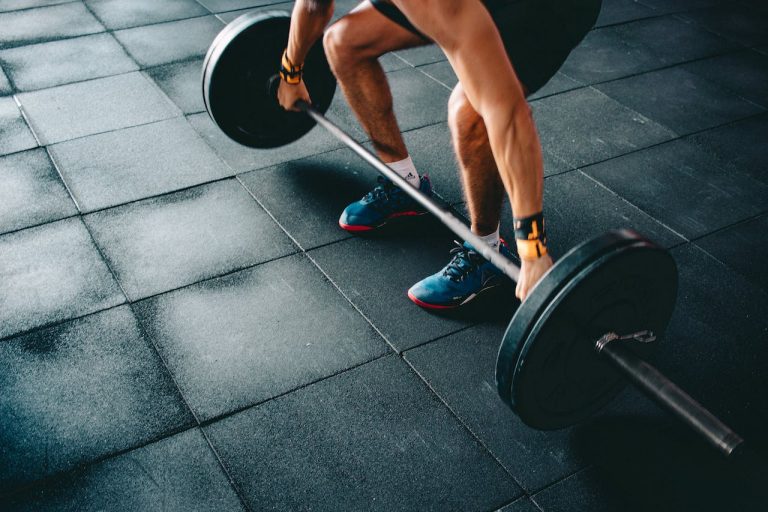In the world of fitness, the debate between HIIT vs strength training stands tall. Each method, revered for its unique benefits, promises to lead its followers towards their pinnacle of physical fitness.
But as we stand at the crossroads of HIIT vs strength training, a question arises: which path is ideal for your personal health and fitness goals? Let’s embark on a journey to unravel this mystery.
Table of contents
MORE keyboard_double_arrow_down LESS keyboard_double_arrow_up
Understanding HIIT And Strength Training
First, let’s start off by understanding what exactly is HIIT (High Intensity Interval Training) and strength training.
HIIT

A powerhouse of efficiency, HIIT(high-intensity interval training) is all about pushing your limits through quick, intense bursts of exercise followed by short, sometimes active, recovery periods. This method is a favorite among those strapped for time, promising significant cardiovascular improvements and calorie burn in sessions as short as 20 minutes.
Strength Training

Strength training focuses on building muscle and strength through resistance exercises. Whether it’s free weights, machines, or bodyweight exercises, strength training is about the slow and steady journey towards increased muscle mass and metabolic rate.
What Makes Each Method Unique?
At first glance, these methods may seem distinct, each with its approach to strengthening your body. However, as we look closer, their contributions to overall fitness and well-being become more intertwined, especially when considering the concept of functional strength.
HIIT: The Powerhouse of Efficiency
HIIT, or High-Intensity Interval Training, is remarkably impactful. Its structure, as mentioned before, consists of high-energy bursts followed by brief periods of rest, and targets the body’s aerobic and anaerobic systems.
This dual engagement not only accelerates cardiovascular improvements but also enhances metabolic rate. This leads to more calories burned both during and after workouts. But HIIT isn’t just about heart rates and sweat. It tests your body’s resilience, pushing limits and expanding boundaries of endurance and power.
Strength Training: The Architect of Muscle
In comparison to HIIT, strength training takes a measured, deliberate path. It builds, shapes, and fortifies the body’s musculature through resistance exercises.
Free weights, machines, or even bodyweight movements serve as ideal equipment for this method. Each repetition helps to build physical strength. Furthermore, strength training improves posture, enhances bone density, and reduces the risk of injury.
For example, take a look at this Instagram post that perfectly outlines the difference between HIIT vs Strength training and what makes each one unique:
What Do Experts Say About HIIT vs Strength Training?
When it comes to comparing High-Intensity Interval Training (HIIT) and strength training, experts have varying opinions on their benefits and effectiveness. So, here is what they say:
Dr. Martin Gibala, a professor of kinesiology at McMaster University, is a renowned expert in the field of HIIT. He states, “There is good evidence that HIIT provides superior cardiovascular and metabolic benefits compared to traditional moderate-intensity continuous training.”
Dr. Gibala’s research has been instrumental in highlighting the effectiveness of HIIT in improving cardiovascular health and overall fitness.
When it comes to strength training, Dr. Stuart Phillips, a professor in the Department of Kinesiology at McMaster University, emphasizes the importance of strength training. He asserts, “Resistance exercise is the most effective way to increase muscle mass and strength.”
Dr. Phillips’ extensive research in muscle physiology and nutrition underscores the significance of strength training for overall health and wellness.
Furthermore, Dr. Brad Schoenfeld, an internationally renowned fitness expert and author, offers a comparative analysis of HIIT and strength training.
He suggests, “Both HIIT and strength training offer unique benefits. HIIT is effective for improving cardiovascular fitness and burning calories, while strength training is essential for building muscle mass and enhancing metabolic rate.”
Thus, the consensus among experts is that both HIIT and strength training offer valuable benefits. While HIIT is effective for improving cardiovascular health and burning calories, strength training plays a crucial role in building muscle mass and enhancing overall metabolic rate.
So, said in short, experts recognize the distinct advantages of both HIIT and strength training, emphasizing that incorporating a combination of both into one’s fitness regimen can lead to optimal results.
The Role of Functional Strength in Fitness
Functional strength training bridges the gap between gym workouts and real-world activities. It helps to prepare your body for the daily demands placed upon it. This includes carrying groceries to climbing stairs or even sprinting to catch a bus.
But how do these practices—HIIT and strength training—contribute to functional strength? Let’s take a look.
HIIT and Functional Strength
HIIT, with its dynamic range of movements and explosive intervals, mirrors the unpredictability of real-life physical demands. It trains the heart, lungs, and muscles to respond swiftly and efficiently to sudden challenges. Thus, this enhances one’s ability to perform under various circumstances.
Strength Training’s Contribution to Functional Strength
On the other side, strength training’s methodical approach to building muscle ensures that the body has the raw power and endurance needed for everyday tasks. It focuses on key movement patterns—such as squats, deadlifts, and presses. This cultivates a foundation of strength that translates into improved functionality across a spectrum of activities.
HIIT vs Strength Training in Building Functional Strength
So, is HIIT strength training? And how does it stack up against traditional weight training in cultivating functional strength? The answer lies not in choosing one over the other but in recognizing the unique contributions of each.
Together, they create a well-rounded fitness regimen that not only enhances functional strength but also ensures a balanced, adaptable body capable of facing life’s physical challenges head-on.
HIIT vs Weight Training: A Detailed Comparison
When we compare HIIT against weight training, both are champions in their domains. However, they bring different strengths when it comes to fitness.
HIIT, or High-Intensity Interval Training, is your go-to for a quick, intense workout that gets your heart pumping and calories burning. It’s perfect for those days when you’re short on time but still want a workout that packs a punch.
Weight training, on the other hand, is the cornerstone of muscle building and strength. It’s about lifting, pushing, and pulling your way to a stronger you. With weight training, you’re not just working out; you’re building a foundation of muscle that will improve your metabolism even when you’re not sweating it out at the gym.
Integrating HIIT and Strength Training for Maximum Benefit
The secret to testing your full potential may lie in the combination of HIIT and strength training. Imagine a fitness regimen where the heart-pounding exhilaration of HIIT meets the steadfast growth of strength training.
But how do you balance the intensity of HIIT with the discipline of strength training without overtaxing your body? Below we explain how you can do this.
Crafting Your HIIT and Strength Training Routine
Creating a routine that effectively blends HIIT and strength training requires a bit of finesse. Here’s a simple yet effective plan to get you started:
- Monday: Kick off the week with a heavy strength training session. Focus on compound movements like squats and deadlifts that work for multiple muscle groups.
- Wednesday: Midweek, switch gears to a HIIT session. Keep it short and sweet, with intervals that push your heart rate up and give you a full-body workout.
- Friday: Round out your week with another strength session, this time focusing on different muscle groups or incorporating more isolation exercises.
This schedule keeps your body guessing and maximizes both fat loss and muscle gain. However, it’s clear that the journey towards fitness is not a one-size-fits-all path. Your personal goals, lifestyle, and preferences play an important role.
Whether you’re drawn to the swift intensity of HIIT or the gradual strength building of weight training, remember: the best workout is the one that you consistently do.
The Truth About HIIT and Strength Training
In the fitness world, there are many myths surrounding HIIT and strength training. This can make it difficult to identify what to believe. Thus, below we will aim to clear out two of the most common myths surrounding this topic:
Myth 1: “HIIT can replace strength training.”
Not quite. HIIT is fantastic for cardiovascular fitness and quick calorie burn, but it doesn’t build muscle in the same way that lifting weights does.
Myth 2: “Strength training makes you bulky, not fit.”
False. Strength training builds lean muscle, which boosts your metabolism and shapes your body, making you stronger and more toned, not necessarily “bulky.”
Wrapping It Up
As we draw this exploration to a close, the message is clear: HIIT and strength training each have their unique place in a well-rounded fitness regimen. The choice isn’t about one or the other; it’s about how to use them together to meet your personal fitness goals.
So, as you contemplate your next workout, ask yourself, what will it be today? HIIT, weight training, or a bit of both? And how will your fitness journey evolve as you take these insights and put them into action? The path to fitness is filled with discovery, and your journey is just beginning.
Key Points
- HIIT excels in boosting cardiovascular health, burning calories quickly, and improving metabolic rate.
- Strength training builds muscle mass and strength, enhances bone density, and reduces injury risk.
- HIIT mimics real-life demands with dynamic movements and prepares for sudden challenges.
- Strength training builds the raw power and endurance needed for daily tasks.
- A balanced approach maximizes fat loss, muscle gain, and overall fitness.
- Start with what you enjoy and gradually increase intensity.
- Listen to your body and prioritize rest for recovery.
- Beginners can do both, starting at a comfortable level and seeking guidance if needed.
- Remember, the best workout is the one you do consistently
FAQs
Can I do HIIT and strength training on the same day?
Yes, you can, but it’s crucial to listen to your body and not overdo it. For optimal results, consider focusing on one per session or separating them into AM/PM workouts.
Will HIIT help me build muscle?
While HIIT is excellent for cardiovascular fitness and fat loss, it’s not primarily designed for muscle building. Strength training should be your go-to for muscle gains.
How often should I do HIIT vs strength training?
A balanced approach might include 2-3 days of HIIT and 2-4 days of strength training per week, ensuring you have adequate rest for recovery.
Is strength training or HIIT better for weight loss?
Both! HIIT is efficient for quick calorie burn, while strength training increases muscle mass, which in turn boosts your metabolism and aids in long-term weight management.
Can beginners do HIIT and strength training?
Absolutely! Start at a level that’s comfortable for you and gradually increase the intensity. Consider working with a fitness professional to ensure proper form and technique.
References and Citations
Throughout this journey, we’ve relied on expert opinions, scientific research, and practical experiences to guide our exploration of HIIT vs strength training.

ABOUT THE AUTHOR
Follow Valen Steven for a dose of fitness enthusiasm, evidence-based advice, and a roadmap to achieving your health and wellness goals.
Subscribe to our Newsletter
Dive into a world of fitness and wellness with our exclusive newsletter! Sign up now and receive weekly power-packs of fitness wisdom




